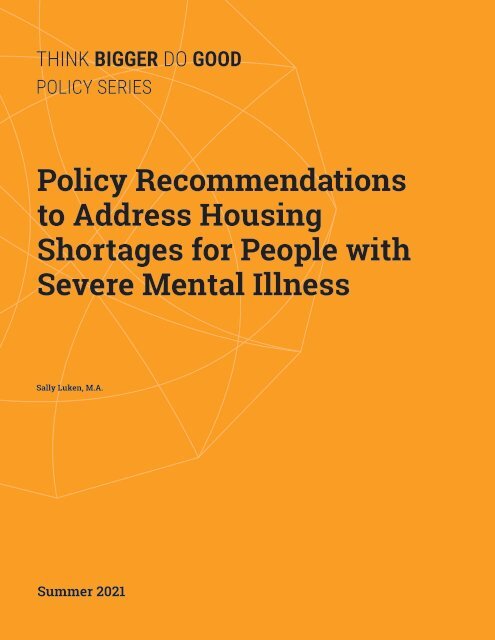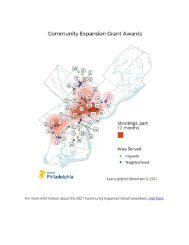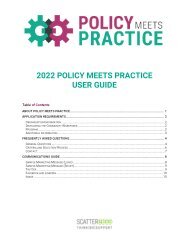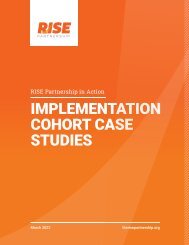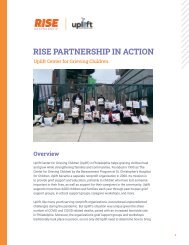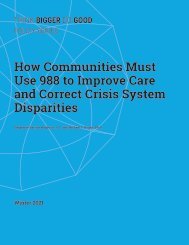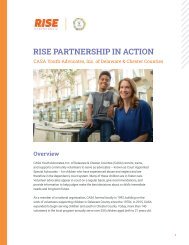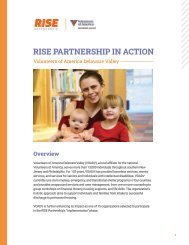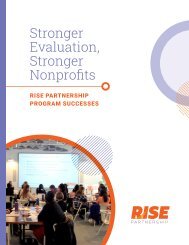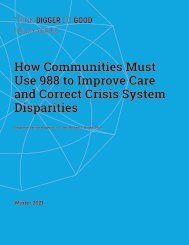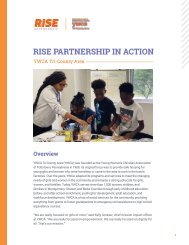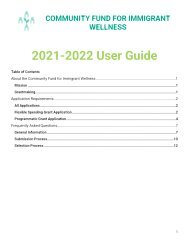Policy Recommendations to Address Housing Shortages for People with Severe Mental Illness
Create successful ePaper yourself
Turn your PDF publications into a flip-book with our unique Google optimized e-Paper software.
THINK BIGGER DO GOOD<br />
POLICY SERIES<br />
<strong>Policy</strong> <strong>Recommendations</strong><br />
<strong>to</strong> <strong>Address</strong> <strong>Housing</strong><br />
<strong>Shortages</strong> <strong>for</strong> <strong>People</strong> <strong>with</strong><br />
<strong>Severe</strong> <strong>Mental</strong> <strong>Illness</strong><br />
Sally Luken, M.A.<br />
Summer 2021<br />
<strong>Policy</strong> <strong>Recommendations</strong> <strong>to</strong> <strong>Address</strong> <strong>Housing</strong> <strong>Shortages</strong> <strong>for</strong> <strong>People</strong> <strong>with</strong> <strong>Severe</strong> <strong>Mental</strong> <strong>Illness</strong> 1
Behavioral Health and the Individual Health Insurance Market
Dear Reader,<br />
Now is the time <strong>to</strong> solve the growing behavioral health needs in our country by advancing public<br />
policies that trans<strong>for</strong>m the delivery of mental health and substance use disorder services and address<br />
outdated funding mechanisms.<br />
This paper is part of Think Bigger Do Good, a series of papers launched in 2017 through the support and<br />
leadership of the Thomas Scattergood Behavioral Health Foundation and Peg’s Foundation. While the<br />
paper <strong>to</strong>pics continue <strong>to</strong> evolve, our goal <strong>to</strong> develop a policy agenda <strong>to</strong> improve health outcomes <strong>for</strong> all<br />
remains constant.<br />
In partnership <strong>with</strong> national experts in behavioral health, including our edi<strong>to</strong>rs, Howard Goldman<br />
and Constance Gartner, we identified seven critical <strong>to</strong>pics <strong>for</strong> this third series of papers. Each paper<br />
identifies the problem and provides clear, actionable solutions.<br />
We hope you join us in advocating <strong>for</strong> stronger behavioral health policies by sharing this paper <strong>with</strong><br />
your programmatic partners, local, state, and federal decision makers, advocacy organizations, and<br />
voters. To learn more about Think Bigger Do Good and <strong>to</strong> access the other papers in the series, visit<br />
www.thinkbiggerdogood.org.<br />
Sincerely,<br />
Joseph Pyle, M.A.<br />
President<br />
Scattergood Foundation<br />
Founding Partner of Series<br />
Rick Kellar, M.B.A.<br />
President<br />
Peg’s Foundation<br />
Founding Partner of Series<br />
Jane Mogavero, Esq.<br />
Executive Direc<strong>to</strong>r<br />
Patrick P. Lee Foundation<br />
Tracy A. Sawicki<br />
Executive Direc<strong>to</strong>r<br />
Peter & Elizabeth Tower Foundation<br />
<strong>Policy</strong> <strong>Recommendations</strong> <strong>to</strong> <strong>Address</strong> <strong>Housing</strong> <strong>Shortages</strong> <strong>for</strong> <strong>People</strong> <strong>with</strong> <strong>Severe</strong> <strong>Mental</strong> <strong>Illness</strong> 3
We would like <strong>to</strong> acknowledge the following individuals <strong>for</strong> their participation in<br />
the meeting that led <strong>to</strong> the conceptualization of the paper series.<br />
Colleen L. Barry, Ph.D., M.P.P.<br />
John Hopkins Bloomberg School of<br />
Public Health<br />
Cynthia Baum-Baicker, Ph.D.<br />
The Scattergood Foundation<br />
Anita Burgos, Ph.D.<br />
Bipartisan <strong>Policy</strong> Center<br />
Thom Craig, M.P.A.<br />
Peg’s Foundation<br />
Rebecca David, M.P.H.<br />
National Council <strong>for</strong> Behavioral Health<br />
Kelly Davis<br />
<strong>Mental</strong> Health America<br />
Lisa Dixon, M.D., M.P.H.<br />
Columbia University, NY State Psychiatric<br />
Institute, and Psychiatric Services<br />
Sara Dugan, Pharm.D., B.C.P.P., B.C.P.S.<br />
Northeast Ohio Medical University<br />
Peter Earley<br />
Author & Journalist<br />
Alyson Ferguson, M.P.H.<br />
The Scattergood Foundation<br />
Richard Frank, Ph.D.<br />
Harvard Medical School<br />
Rachel Garfield, Ph.D., M.H.S.<br />
The Henry J. Kaiser Family Foundation<br />
Mary Giliberti, J.D.<br />
<strong>Mental</strong> Health America<br />
Aaron Glickman, B.A.<br />
Perelman School of Medicine,<br />
University of Pennsylvania<br />
Sherry Glied, Ph.D.<br />
NYU Wagner School of Public Service<br />
Howard Goldman, M.D., Ph.D.<br />
University of Maryland School<br />
of Medicine<br />
Pamela Greenberg, M.P.P.<br />
Association <strong>for</strong> Behavioral Health<br />
and Wellness<br />
Kimberly Hoagwood, Ph.D.<br />
New York University School of Medicine<br />
Michael F. Hogan, Ph.D.<br />
Hogan Health Solutions<br />
Chuck Ingoglia, M.S.W.<br />
National Council <strong>for</strong> Behavioral Health<br />
Rick Kellar, M.B.A.<br />
Peg’s Foundation<br />
Kelly Kelleher, M.D., M.P.H.<br />
The Research Institute at Nationwide<br />
Children’s Hospital<br />
Jennifer Mathis, J.D.<br />
Bazelon Center <strong>for</strong> <strong>Mental</strong> Health Law<br />
Donald Matteson, M.A.<br />
Peter & Elizabeth Tower Foundation<br />
Brian McGregor, Ph.D.<br />
Satcher Health Leadership Institute,<br />
Morehouse College<br />
Erik Messamore, M.D.<br />
Northeast Ohio Medical University<br />
Ben Miller, PsyD<br />
Well Being Trust<br />
Jane Mogavero, Esq.<br />
Patrick P. Lee Foundation<br />
Mark R. Munetz, M.D.<br />
Northeast Ohio Medical University<br />
Sandra Newman, Ph.D.<br />
John Hopkins Bloomberg School of<br />
Public Health<br />
Joseph Pyle, M.A.<br />
The Scattergood Foundation<br />
Barbara Ricci<br />
Center <strong>for</strong> High Impact Philanthropy<br />
Cheryl Roberts, Esq.<br />
Greenberger Center<br />
Vic<strong>to</strong>ria Romanda<br />
Peg’s Foundation<br />
Tracy A. Sawicki<br />
Peter & Elizabeth Tower Foundation<br />
Lloyd Sederer, M.D.<br />
NYS Office of <strong>Mental</strong> Health/Mailman<br />
School of Public Health<br />
Dominic Sisti, Ph.D.<br />
Scattergood Program <strong>for</strong> Applied Ethics<br />
in Behavioral Health Care & Perelman<br />
School of Medicine at the University<br />
of Pennsylvania<br />
Andrew Sperling, J.D.<br />
NAMI<br />
Kate Williams, J.D.<br />
The Scattergood Foundation<br />
Glenda L. Wrenn, M.D., M.S.H.P.<br />
180 Health Partners<br />
<strong>Policy</strong> <strong>Recommendations</strong> <strong>to</strong> <strong>Address</strong> <strong>Housing</strong> <strong>Shortages</strong> <strong>for</strong> <strong>People</strong> <strong>with</strong> <strong>Severe</strong> <strong>Mental</strong> <strong>Illness</strong> 4
Titles in the Paper Series<br />
Edi<strong>to</strong>rs Howard Goldman, M.D., Ph.D., and Constance Gartner, M.S.W.<br />
America’s Opioid Epidemic<br />
Lloyd I. Sederer, M.D.<br />
Behavioral Health and the Individual Health Insurance Market: Preserving Key Elements of Re<strong>for</strong>m<br />
Richard G. Frank, Ph.D., and Sherry A. Glied, Ph.D., M.A.<br />
Bringing Treatment Parity <strong>to</strong> Jail Inmates <strong>with</strong> Schizophrenia<br />
Mark R. Munetz, M.D., Erik Messamore, M.D., Ph.D., and Sara E. Dugan, Pharm.D., B.C.P.P., B.C.P.S.<br />
Coordinated Specialty Care <strong>for</strong> First-Episode Psychosis: An Example of Financing <strong>for</strong> Specialty Programs<br />
Lisa B. Dixon, M.D., M.P.H.<br />
COVID-19, Structural Racism, and <strong>Mental</strong> Health Inequities: <strong>Policy</strong> Implications <strong>for</strong> an Emerging Syndemic<br />
Ruth S. Shim, M.D., M.P.H., and Steven M. Starks, M.D.<br />
Employing <strong>People</strong> <strong>with</strong> <strong>Mental</strong> <strong>Illness</strong> in the 21st Century: Labor Market Changes and <strong>Policy</strong> Challenges<br />
Richard G. Frank, Ph.D., and Sherry A. Glied, Ph.D., M.A.<br />
Fentanyl and the Evolving Opioid Epidemic: What Strategies Should <strong>Policy</strong>makers Consider?<br />
Colleen L. Barry, Ph.D., M.P.P.<br />
<strong>Housing</strong> Is <strong>Mental</strong> Health Care: A Call <strong>for</strong> Medicaid Demonstration Waivers Covering <strong>Housing</strong><br />
Jennifer Mathis, J.D.<br />
Improving Outcomes <strong>for</strong> <strong>People</strong> <strong>with</strong> Serious <strong>Mental</strong> <strong>Illness</strong> and Co-Occurring Substance Use<br />
Disorders in Contact <strong>with</strong> the Criminal Justice System<br />
Glenda L. Wrenn, M.D., M.S.H.P., Brian McGregor, Ph.D., and Mark R. Munetz, M.D.<br />
In<strong>for</strong>med Consent: A <strong>Policy</strong> Prescription <strong>for</strong> Communicating Benefit and Risk in State Medical Marijuana Program<br />
Erik Messamore, M.D., Ph.D., and Sara E. Dugan, Pharm.D., B.C.P.P., B.C.P.S.<br />
Integrating <strong>Mental</strong> Health and Addiction Treatment in General Medical Care: The Role of <strong>Policy</strong><br />
Emma B. McGinty, Ph.D., M.S., and Gail L. Daumit, M.D., M.H.S.<br />
Medicaid’s Institutions <strong>for</strong> <strong>Mental</strong> Diseases (IMD) Exclusion Rule: A <strong>Policy</strong> Debate<br />
Jennifer Mathis, J.D., Dominic A. Sisti, Ph.D., and Aaron Glickman, B.A.<br />
Meeting the Needs of Justice-Involved <strong>People</strong> <strong>with</strong> Serious <strong>Mental</strong> <strong>Illness</strong> <strong>with</strong>in Community<br />
Behavioral Health Systems<br />
Natalie Bonfine, Ph.D., Amy Blank Wilson, Ph.D., L.S.W., and Mark R. Munetz, M.D.<br />
New Opportunities <strong>to</strong> Improve <strong>Mental</strong> Health Crisis Systems<br />
Michael F. Hogan, Ph.D., and Mathew L. Goldman, M.D., M.S.<br />
<strong>Policy</strong> <strong>Recommendations</strong> <strong>to</strong> <strong>Address</strong> <strong>Housing</strong> <strong>Shortages</strong> <strong>for</strong> <strong>People</strong> <strong>with</strong> <strong>Severe</strong> <strong>Mental</strong> <strong>Illness</strong> 5
Redesigning Federal Health Insurance Policies <strong>to</strong> Promote Children’s <strong>Mental</strong> Health<br />
Kimberly Hoagwood, Ph.D., Kelly Kelleher, M.D., M.P.H., and Michael F. Hogan, Ph.D.<br />
<strong>Policy</strong> and Practice Innovations <strong>to</strong> Improve Prescribing of Psychoactive Medications <strong>for</strong> Children<br />
Kelly J. Kelleher, M.D., M.P.H., David Rubin, M.D., M.S.C.E., and Kimberly Hoagwood, Ph.D.<br />
Preventing Suicide Through Better Firearm Safety <strong>Policy</strong> in the United States<br />
Jeffrey W. Swanson, Ph.D.<br />
Systemic, Racial Justice–In<strong>for</strong>med Solutions <strong>to</strong> Shift “Care” From the Criminal Legal System <strong>to</strong><br />
the <strong>Mental</strong> Health Care System<br />
Sarah Y. Vinson, M.D., and Andrea L. Dennis, J.D.<br />
Suicide Is a Significant Health Problem<br />
Michael F. Hogan, Ph.D.<br />
The Current Medicaid <strong>Policy</strong> Debate and Implications <strong>for</strong> Behavioral Healthcare in the United States<br />
Rachel Garfield, Ph.D., M.H.S., and Julia Zur, Ph.D.<br />
Youth Suicide Is Increasing: Modest Actions Taken Now Can Save Lives<br />
Michael F. Hogan, Ph.D.<br />
Find the papers online at www.thinkbiggerdogood.org<br />
We are grateful <strong>for</strong> the partnership that allows this paper and others <strong>to</strong> appear<br />
in Psychiatric Services, a peer-reviewed monthly journal of the American Psychiatric<br />
Association. Content can be viewed at ps.psychiatryonline.org.<br />
<strong>Policy</strong> <strong>Recommendations</strong> <strong>to</strong> <strong>Address</strong> <strong>Housing</strong> <strong>Shortages</strong> <strong>for</strong> <strong>People</strong> <strong>with</strong> <strong>Severe</strong> <strong>Mental</strong> <strong>Illness</strong> 6
<strong>Policy</strong> <strong>Recommendations</strong><br />
<strong>to</strong> <strong>Address</strong> <strong>Housing</strong><br />
<strong>Shortages</strong> <strong>for</strong> <strong>People</strong> <strong>with</strong><br />
<strong>Severe</strong> <strong>Mental</strong> <strong>Illness</strong><br />
Sally Luken, M.A.<br />
Founder and President<br />
Luken Solutions<br />
sally.luken@lukensolutions.com<br />
<strong>Policy</strong> <strong>Recommendations</strong> <strong>to</strong> <strong>Address</strong> <strong>Housing</strong> <strong>Shortages</strong> <strong>for</strong> <strong>People</strong> <strong>with</strong> <strong>Severe</strong> <strong>Mental</strong> <strong>Illness</strong> 7
U.S. households <strong>with</strong> very low<br />
incomes are disadvantaged in finding<br />
suitable and af<strong>for</strong>dable housing—an<br />
important social determinant of health.<br />
Add <strong>to</strong> poverty the often-disabling<br />
health condition of mental illness, and<br />
these households fall further behind<br />
in the line of households waiting <strong>for</strong><br />
housing opportunities (1).<br />
<strong>Policy</strong> <strong>Recommendations</strong> <strong>to</strong> <strong>Address</strong> <strong>Housing</strong> <strong>Shortages</strong> <strong>for</strong> <strong>People</strong> <strong>with</strong> <strong>Severe</strong> <strong>Mental</strong> <strong>Illness</strong> 8
1<br />
Critical <strong>Housing</strong><br />
Shortage Continues <strong>for</strong><br />
Persons <strong>with</strong> <strong>Severe</strong><br />
<strong>Mental</strong> <strong>Illness</strong><br />
Adults <strong>with</strong> mental health issues whose sole source of income is Supplemental<br />
Security Income—approximately $783 per month—are unable <strong>to</strong> pay monthly<br />
rent, which averages $1,022 per month, be<strong>for</strong>e accounting <strong>for</strong> other costs of basic<br />
living (2). Our system of financial support <strong>for</strong> our most disabled citizens—those<br />
<strong>with</strong> serious and persistent mental illness—assumes that the individual has other<br />
methods of support. This limited income source, <strong>with</strong>out guarantees of other<br />
support, especially housing, cruelly predestines individuals <strong>with</strong> mental illness <strong>to</strong><br />
a possible life of housing instability, including homelessness and cycling in and<br />
out of institutions.<br />
In 2009, Newman and Goldman (3) cited evidence that individuals experiencing<br />
severe and persistent mental illness could live in independent housing and<br />
noted that social service supports should be available <strong>for</strong> those who need them.<br />
Although these authors concluded that the evidence base on effectiveness<br />
of various approaches <strong>to</strong> housing was slim, their conclusions nevertheless<br />
encourage policies promoting supportive housing. They also noted that access<br />
<strong>to</strong> housing was limited and that would-be tenants <strong>with</strong> mental illness reported<br />
discrimina<strong>to</strong>ry practices. Newman and Goldman called <strong>for</strong> expansion of<br />
opportunities and resources and <strong>for</strong> more research.<br />
<strong>Policy</strong> <strong>Recommendations</strong> <strong>to</strong> <strong>Address</strong> <strong>Housing</strong> <strong>Shortages</strong> <strong>for</strong> <strong>People</strong> <strong>with</strong> <strong>Severe</strong> <strong>Mental</strong> <strong>Illness</strong> 9
There are no set-asides or prioritization systems in<br />
federal housing programs <strong>for</strong> people <strong>with</strong> mental<br />
illness—the missing component. The lack of a<br />
coordinated directive from federal policy makers<br />
and a misapplication of federal nondiscrimination<br />
laws, such as Section 504 of the Americans<br />
With Disabilities Act (ADA) and the Olmstead<br />
settlements, perpetuate housing limitations <strong>for</strong><br />
people <strong>with</strong> serious mental illness.<br />
In 2020, Leopold (4) updated the research base and concluded that even in the<br />
absence of strong research answers <strong>to</strong> questions about comparative effectiveness<br />
of specific policies, experts have proposed a number of practical policy solutions.<br />
Leopold called <strong>for</strong> an expansion of funding in the federal government’s 811<br />
program, and Mathis (1) proposed expanding options in Medicaid <strong>for</strong> housing.<br />
Expansion of resources, although needed, does not provide the missing piece in<br />
federal policy <strong>to</strong> address the problem. There are no set-asides or prioritization<br />
systems in federal housing programs <strong>for</strong> people <strong>with</strong> mental illness—the missing<br />
component. The lack of a coordinated directive from federal policy makers<br />
and a misapplication of federal nondiscrimination laws, such as Section 504<br />
of the Americans With Disabilities Act (ADA) and the Olmstead settlements,<br />
perpetuate housing limitations <strong>for</strong> people <strong>with</strong> serious mental illness. This article<br />
analyzes the problem and offers policy proposals <strong>to</strong> increase federal funds while<br />
prioritizing this severely underserved population.<br />
<strong>Policy</strong> <strong>Recommendations</strong> <strong>to</strong> <strong>Address</strong> <strong>Housing</strong> <strong>Shortages</strong> <strong>for</strong> <strong>People</strong> <strong>with</strong> <strong>Severe</strong> <strong>Mental</strong> <strong>Illness</strong> 10
2<br />
The Need <strong>for</strong><br />
Additional Units<br />
per the Data<br />
Approximately 116,000 people <strong>with</strong> mental illness are homeless in the United<br />
States (5), and, although estimates vary, as many as 843,000 people <strong>with</strong> mental<br />
illness are incarcerated (6, 7). These figures do not account <strong>for</strong> the thousands<br />
couch surfing, those living <strong>with</strong> aging parents who are unable <strong>to</strong> cope <strong>with</strong> the<br />
episodic nature of the illness, or those who remain stuck in other institutional<br />
settings.<br />
The United States lacks a national database or<br />
federally coordinated data collection system <strong>to</strong><br />
determine the number and type of housing units<br />
needed <strong>to</strong> house the nearly one million individuals<br />
<strong>with</strong> mental illness estimated <strong>to</strong> be homeless,<br />
incarcerated, or poorly housed (5–7).<br />
The number of housing units needed <strong>to</strong> address this population is unknown. The<br />
United States lacks a national database or federally coordinated data collection<br />
system <strong>to</strong> determine the number and type of housing units needed <strong>to</strong> house the<br />
nearly one million individuals <strong>with</strong> mental illness estimated <strong>to</strong> be homeless,<br />
incarcerated, or poorly housed (5–7). No national database exists, because a<br />
federal policy <strong>to</strong> eradicate the problem has never developed.<br />
<strong>Policy</strong> <strong>Recommendations</strong> <strong>to</strong> <strong>Address</strong> <strong>Housing</strong> <strong>Shortages</strong> <strong>for</strong> <strong>People</strong> <strong>with</strong> <strong>Severe</strong> <strong>Mental</strong> <strong>Illness</strong> 11
Many states and local communities have developed<br />
their own housing goals, but often these have not<br />
addressed the need. In more recent years, goals have<br />
been embedded in the federal policy <strong>to</strong> end homelessness<br />
or <strong>to</strong> meet legal settlements between the U.S. Department<br />
of Justice (DOJ) and local governments <strong>to</strong> uphold the<br />
Supreme Court’s 1999 Olmstead decision, which found<br />
that the unjustified segregation of people <strong>with</strong> disabilities<br />
is a <strong>for</strong>m of unlawful discrimination under the ADA.<br />
These ef<strong>for</strong>ts have worthy goals, but they do not address<br />
persons <strong>with</strong> mental health illness who do not meet the<br />
federal homeless definitions or who are overlooked in<br />
Olmstead settlements.<br />
Laws developed <strong>to</strong> protect the rights of disabled persons<br />
have had unintended consequences in housing <strong>for</strong><br />
people <strong>with</strong> mental illness. Section 504 of the ADA does<br />
not allow a qualified individual <strong>to</strong> be denied access <strong>to</strong> or<br />
discriminated against in federally funded programs or<br />
services on the basis of the person’s disabilities. This has<br />
been interpreted <strong>to</strong> mean that under no circumstance<br />
should one disability class have preference over<br />
another in housing access. However, Section 504 allows<br />
distinctions based on disabilities, if the distinction<br />
provides “equal access <strong>to</strong> housing” (8). U.S. Department<br />
of <strong>Housing</strong> and Urban Development (HUD) officials have<br />
stated that if Congress provides an authorizing statute or<br />
if the Administration provides an executive order, federal<br />
housing programs can limit occupancy <strong>to</strong> people <strong>with</strong><br />
one particular disability (9).<br />
Olmstead settlements have caused some local<br />
governments <strong>to</strong> believe that prioritizing federal housing<br />
resources <strong>for</strong> any particular disability group is a violation<br />
of law. Yet, the DOJ, which litigates these cases, found<br />
that the plaintiffs in M.G. v. Cuomo had standing <strong>to</strong> make<br />
a claim that New York State did not provide adequate<br />
community-based mental health housing and services<br />
<strong>for</strong> people <strong>with</strong> mental illness leaving state prison. The<br />
DOJ stated that <strong>with</strong>out mental health housing, this<br />
disability group was being segregated upon release (in<br />
homeless shelters) or was at risk of reinstitutionalization,<br />
both violations of federal law (10).<br />
The lack of a directive from the federal government, <strong>with</strong><br />
the patchwork of funding, makes solving the shortage<br />
of housing <strong>for</strong> persons <strong>with</strong> mental illness a challenge,<br />
whether in New York City or Des Moines. A federal and<br />
state compact <strong>with</strong> robust financial supports and specific<br />
goals prioritizing this population is needed.<br />
A federal and state compact <strong>with</strong><br />
robust financial supports and specific<br />
goals prioritizing this population<br />
is needed.<br />
<strong>Policy</strong> <strong>Recommendations</strong> <strong>to</strong> <strong>Address</strong> <strong>Housing</strong> <strong>Shortages</strong> <strong>for</strong> <strong>People</strong> <strong>with</strong> <strong>Severe</strong> <strong>Mental</strong> <strong>Illness</strong> 12
3<br />
Necessary<br />
Components of<br />
Af<strong>for</strong>dable <strong>Housing</strong><br />
Development and<br />
Operations<br />
Development of new housing units <strong>for</strong> persons <strong>with</strong> disabilities requires what<br />
housing experts refer <strong>to</strong> as the three legs of the s<strong>to</strong>ol: capital, operations, and<br />
services.<br />
Capital Sources and Uses<br />
Capital is used <strong>to</strong> acquire land or buildings, construct new units, or rehabilitate<br />
existing units. There is a myriad of costs in these tasks, including architectural;<br />
engineering; legal; environmental; inves<strong>to</strong>r requirements; federal, state, and local<br />
regula<strong>to</strong>ry requirements; licensing; fees; insurance; utilities; property taxes; and<br />
debt services.<br />
The Low-Income <strong>Housing</strong> Tax Credit (LIHTC) program is the largest source of<br />
capital funding in the United States <strong>for</strong> housing that is built <strong>for</strong> low- or moderateincome<br />
households. A Treasury Department program, created by the Tax Re<strong>for</strong>m<br />
Act of 1986, the LIHTC program gives state and local agencies the equivalent of<br />
approximately $8 billion in annual budget authority <strong>to</strong> issue tax credits <strong>for</strong> the<br />
acquisition, rehabilitation, or new construction of rental housing targeted <strong>to</strong><br />
lower-income households (11).<br />
<strong>Policy</strong> <strong>Recommendations</strong> <strong>to</strong> <strong>Address</strong> <strong>Housing</strong> <strong>Shortages</strong> <strong>for</strong> <strong>People</strong> <strong>with</strong> <strong>Severe</strong> <strong>Mental</strong> <strong>Illness</strong> 13
The median cost <strong>to</strong> create one, one-bedroom apartment<br />
using LIHTC is nearly $186,000 in 2020 dollars (12). That per<br />
unit cost is heavily influenced by location and density of<br />
a project. Building an apartment building in Los Angeles<br />
costs more than in Ocala, Florida; 25 units is more costly<br />
per unit than 250. Other fac<strong>to</strong>rs contribute <strong>to</strong> capital cost<br />
per unit, such as a lack of raw materials, newly imposed<br />
import tariffs on items such as appliances, or a legal battle<br />
against local citizens who object <strong>to</strong> a project arguing<br />
“Not In My Back Yard” (NIMBY), a common occurrence in<br />
af<strong>for</strong>dable housing development, arising from neighbors<br />
or businesses objecting <strong>to</strong> a proposed project in what<br />
they consider their neighborhood and based on bias,<br />
misunderstanding, or fear.<br />
In all jurisdictions across the country,<br />
there is no one source of capital <strong>for</strong><br />
housing development, which requires<br />
a developer <strong>to</strong> braid as many as eight<br />
<strong>to</strong> 12 funding sources <strong>to</strong> cover all the<br />
costs associated <strong>with</strong> any project.<br />
Competition <strong>for</strong> capital resources is high, resulting in<br />
additional costs if applications are repeated multiple<br />
times be<strong>for</strong>e award. The good news is that all of this<br />
complexity has spawned an industry of sophisticated<br />
af<strong>for</strong>dable housing developers. The bad news is that most<br />
do not make a habit of developing housing <strong>for</strong> people <strong>with</strong><br />
mental illness.<br />
Operation Sources and Uses<br />
“Operations” refers <strong>to</strong> the expense of keeping the<br />
apartments functional and taking care of the asset over<br />
time. Landlords also like <strong>to</strong> make a profit, including<br />
nonprofit landlords. Rents are the primary source of<br />
revenues <strong>for</strong> operations.<br />
Mom-and-pop landlords can set their rents at any level<br />
that their local markets will bear. <strong>Housing</strong> developments<br />
that use public funds normally must use fair market rents<br />
(FMRs) <strong>to</strong> set their rent levels. FMRs are established by<br />
HUD. Often additional compliance requirements translate<br />
in<strong>to</strong> the need <strong>for</strong> rents that are high enough <strong>for</strong> a landlord<br />
<strong>to</strong> cover costs. What this means <strong>for</strong> low-income people<br />
<strong>with</strong> mental illness is that rental subsidies are critical <strong>to</strong><br />
their housing success.<br />
Un<strong>for</strong>tunately, an LIHTC award never finances 100% of<br />
a project. In all jurisdictions across the country, there<br />
is no one source of capital <strong>for</strong> housing development,<br />
which requires a developer <strong>to</strong> braid as many as eight <strong>to</strong><br />
12 funding sources <strong>to</strong> cover all the costs associated <strong>with</strong><br />
any project. The time involved in cobbling <strong>to</strong>gether this<br />
patchwork can also be onerous. New developments can<br />
take 2 <strong>to</strong> 6 years. Time is money.<br />
<strong>Policy</strong> <strong>Recommendations</strong> <strong>to</strong> <strong>Address</strong> <strong>Housing</strong> <strong>Shortages</strong> <strong>for</strong> <strong>People</strong> <strong>with</strong> <strong>Severe</strong> <strong>Mental</strong> <strong>Illness</strong> 14
Rental subsidies come in two types:<br />
project-based rental assistance<br />
(PBRA) and tenant-based rental<br />
assistance (TBRA).<br />
Rental subsidies come in two types: project-based rental<br />
assistance (PBRA) and tenant-based rental assistance<br />
(TBRA). PBRA subsidies are attached <strong>to</strong> a particular unit<br />
<strong>with</strong>in a specific building. The subsidy stays <strong>with</strong> the<br />
unit or “project” no matter who the eligible tenant is at<br />
any given time. These are helpful <strong>to</strong> projects that serve<br />
extremely low-income tenants and that may specialize in<br />
meeting goals, such as <strong>to</strong> end homelessness. A consistent<br />
source of rents, such as PBRA subsidies, can financially<br />
stabilize a project. TBRA subsidies do as they sound—the<br />
eligible household receives the rent subsidy and uses it<br />
in any af<strong>for</strong>dable apartment or house where a landlord is<br />
willing <strong>to</strong> accept it. These are helpful <strong>to</strong> the household by<br />
providing choice and portability, if there is an adequate<br />
supply of willing landlords whose units have passed<br />
muster <strong>with</strong> HUD’s housing quality standards.<br />
HUD provides the bulk of rental subsidies <strong>for</strong> eligible<br />
households through mainstream housing choice<br />
vouchers (HCVs)—<strong>for</strong>merly referred <strong>to</strong> as Section 8<br />
vouchers. Other HUD rental subsidies are embedded in<br />
rental units owned by local public housing authorities,<br />
in homeless assistance programs, in the HUD 811<br />
program (described below), and in special, short-term<br />
interventions, such as the nonelderly disabled category of<br />
HCVs. Some local and state governments provide rental<br />
subsidies <strong>to</strong> address a local issue, although many are<br />
intended <strong>for</strong> temporary assistance and expire after 3, 6, or<br />
12 months. Nowhere are rental subsidies an entitlement.<br />
Waitlists are long, and there are challenges <strong>for</strong> people<br />
<strong>with</strong> criminal his<strong>to</strong>ries or ongoing issues <strong>with</strong> recovery <strong>to</strong><br />
obtain a place in line.<br />
<strong>Policy</strong> <strong>Recommendations</strong> <strong>to</strong> <strong>Address</strong> <strong>Housing</strong> <strong>Shortages</strong> <strong>for</strong> <strong>People</strong> <strong>with</strong> <strong>Severe</strong> <strong>Mental</strong> <strong>Illness</strong> 15
Services Sources and Uses<br />
When a disabled person signs a lease and lives<br />
independently, often his or her independence is<br />
actually reliant on some level of support. Supports can<br />
vary depending on the individual’s need and desires.<br />
Supports may include help moving in<strong>to</strong> a unit; provision<br />
of household items; help <strong>with</strong> access <strong>to</strong> communitybased<br />
services, health care, and treatment; support<br />
<strong>with</strong> building a community of friends; and help finding<br />
employment. Service supports help a person <strong>with</strong> mental<br />
illness maintain housing, such as by advocating <strong>with</strong><br />
a landlord when a tenant knowingly or unknowingly<br />
violates the lease or assisting the tenant <strong>to</strong> complete the<br />
rental subsidy recertification paperwork.<br />
There<strong>for</strong>e, state and local<br />
governments or local philanthropy<br />
supplement Medicaid, which leads<br />
<strong>to</strong> inconsistencies across states and<br />
locales in the levels of services that a<br />
person <strong>with</strong> mental illness receives <strong>to</strong><br />
live independently.<br />
Medicaid is the primary source of revenue <strong>for</strong> some of<br />
these supports. In some locations, Medicaid does not<br />
cover what are called “tenancy supports,” only the obvious<br />
medically related services. There<strong>for</strong>e, state and local<br />
governments or local philanthropy supplement Medicaid,<br />
which leads <strong>to</strong> inconsistencies across states and locales<br />
in the levels of services that a person <strong>with</strong> mental illness<br />
receives <strong>to</strong> live independently. Services that are offered<br />
and accepted by the tenant on a voluntary basis are also<br />
most effective in sustaining housing (13).<br />
All three legs of the housing s<strong>to</strong>ol—capital, operations<br />
(rent subsidies), and services—are oversubscribed or<br />
underfunded <strong>to</strong> the need. The sophisticated af<strong>for</strong>dable<br />
housing developers have a choice of developing<br />
new units <strong>for</strong> a variety of moderate- or low-income<br />
households. Private landlords in most markets look <strong>for</strong><br />
tenants <strong>with</strong> higher incomes or better tenancy his<strong>to</strong>ries.<br />
It is more complicated when developing <strong>for</strong>, and then<br />
renting <strong>to</strong>, persons <strong>with</strong> episodic health issues. As a<br />
result, nonprofits or local governments have typically<br />
delivered housing <strong>for</strong> this population at insufficient<br />
quantities.<br />
<strong>Policy</strong> <strong>Recommendations</strong> <strong>to</strong> <strong>Address</strong> <strong>Housing</strong> <strong>Shortages</strong> <strong>for</strong> <strong>People</strong> <strong>with</strong> <strong>Severe</strong> <strong>Mental</strong> <strong>Illness</strong> 16
4<br />
The Federal 811<br />
<strong>Housing</strong> Program <strong>for</strong><br />
Persons <strong>with</strong> Disabilities<br />
From 1960 <strong>to</strong> 1990, the federal government invested funds in two legs of the s<strong>to</strong>ol,<br />
capital and operations (as rent subsidies), <strong>for</strong> new housing <strong>for</strong> “handicapped”<br />
people as a subset of an elderly housing program called 202. This was the first<br />
federal attempt at developing housing <strong>for</strong> people <strong>with</strong> disabilities. The need <strong>for</strong><br />
this housing continued <strong>to</strong> be evident, and in 1990, the Crans<strong>to</strong>n-Gonzalez National<br />
Af<strong>for</strong>dable <strong>Housing</strong> Act provided <strong>for</strong> a special program, Supportive <strong>Housing</strong> <strong>for</strong><br />
Persons <strong>with</strong> Disabilities, referred <strong>to</strong> as 811 (“eight-eleven”) (14).<br />
Through 811, nonprofit organizations applied directly <strong>to</strong> HUD <strong>for</strong> capital grants,<br />
accompanied by 5-year commitments <strong>for</strong> rental subsidies as PBRA. <strong>Housing</strong><br />
types <strong>for</strong> development could include group homes, independent living facilities,<br />
multifamily rental units, condominium units, and cooperative housing <strong>with</strong><br />
limitations on size—not more than eight or 16 units depending on the type. The<br />
nonprofit receiving the 811 funds committed <strong>to</strong> providing the third leg of the<br />
s<strong>to</strong>ol—services. The 811 program also awarded stand-alone TBRA subsidies but at<br />
a smaller amount.<br />
This model provided nonprofit groups, many of which were small organizations,<br />
a single source application <strong>for</strong> two of the funds hardest <strong>to</strong> come by <strong>for</strong> af<strong>for</strong>dable<br />
housing. This was a boon <strong>to</strong> local providers wanting <strong>to</strong> house their own clients<br />
and <strong>for</strong> those in areas <strong>with</strong> little or no capital. The commitment <strong>for</strong> 5 years of<br />
rental subsidy <strong>with</strong> the capital allowed clients <strong>to</strong> skip the long waiting lists <strong>for</strong><br />
other rent subsidies.<br />
What did 811 produce? Actual numbers of units created <strong>for</strong> persons <strong>with</strong><br />
disabilities since 1960 are unknown, but HUD estimates that 30,000 units were<br />
created from 1990 through 2010—or 1,500 new units a year (15). That is a paltry and<br />
low national production pipeline. The units had <strong>to</strong> be available <strong>to</strong> any disability<br />
class as long as the person was age 18 <strong>to</strong> 61. As a result, many units did not house<br />
people <strong>with</strong> mental illness, further diluting the impact <strong>for</strong> this population.<br />
<strong>Policy</strong> <strong>Recommendations</strong> <strong>to</strong> <strong>Address</strong> <strong>Housing</strong> <strong>Shortages</strong> <strong>for</strong> <strong>People</strong> <strong>with</strong> <strong>Severe</strong> <strong>Mental</strong> <strong>Illness</strong> 17
5<br />
The Melville Act<br />
2010 Creates a New<br />
811 Program<br />
Little has been published outlining successes of the early 811 model.<br />
Instead, issues arose that made people question its efficacy and cost. A 2019<br />
Congressional Research Services report <strong>to</strong> Congress on federal housing<br />
programs stated that federal officials worried about the cost per unit (14).<br />
According <strong>to</strong> 811 program experts, advocates <strong>for</strong> the disabled community argued<br />
<strong>for</strong> more integration, others wanted <strong>to</strong> attract the sophisticated developers who<br />
used LIHTC, and Congress wanted <strong>to</strong> shift its role in housing production <strong>to</strong> states<br />
(personal communication, Sperling A., National Alliance <strong>for</strong> the <strong>Mental</strong>ly Ill;<br />
Sloane L., Technical Assistance Collaborative, Feb. 2021). The TBRA (tenant-based<br />
subsidy) component of 811 needed regular reauthorizations <strong>to</strong> preserve existing<br />
units. In other words, rent subsidies needed <strong>to</strong> be maintained beyond the initial<br />
funding period so that existing tenants did not lose their housing.<br />
This squeezed the program from producing new units, because annual<br />
Congressional appropriations were limited. In addition, the 2007–2008 housing<br />
market collapse caused all af<strong>for</strong>dable housing industry stakeholders <strong>to</strong> rethink<br />
financing of housing.<br />
With advocates’ assistance, and <strong>with</strong> an eye on leveraging the largest capital<br />
source—that is, LIHTC—811 was amended. The 2010 Frank Melville Supportive<br />
<strong>Housing</strong> Investment Act did not do away <strong>with</strong> the original model, although some<br />
housing providers thought so. In fact, the Melville Act amended 811 <strong>to</strong> provide<br />
an incentive <strong>for</strong> states <strong>to</strong> be more involved and <strong>to</strong> create greater opportunities<br />
<strong>for</strong> a small number of units dedicated <strong>to</strong> people <strong>with</strong> disabilities in large-scale<br />
af<strong>for</strong>dable housing projects.<br />
<strong>Policy</strong> <strong>Recommendations</strong> <strong>to</strong> <strong>Address</strong> <strong>Housing</strong> <strong>Shortages</strong> <strong>for</strong> <strong>People</strong> <strong>with</strong> <strong>Severe</strong> <strong>Mental</strong> <strong>Illness</strong> 18
The 811 program’s competitive grants <strong>to</strong> states source the<br />
three legs of the s<strong>to</strong>ol differently, according <strong>to</strong> a state’s<br />
plan. Capital is entirely from other sources, most notably<br />
from LIHTC. Operations are 811, using project rental<br />
assistance (PRA), <strong>with</strong> important caveats: the services<br />
must be guaranteed from the state, primarily from<br />
Medicaid, and units dedicated <strong>to</strong> people <strong>with</strong> disabilities<br />
are maxed at 25% in a project.<br />
What It Produces and Benefits<br />
Twenty-seven states are contracting <strong>with</strong> HUD <strong>for</strong> 811<br />
PRA. Nearly 5,500 811 PRA units were identified during<br />
the years 2015 <strong>to</strong> 2020 (federal funds did not flow until<br />
2013) (16). The units, integrated in<strong>to</strong> existing af<strong>for</strong>dable<br />
housing projects, are providing an important alternative<br />
<strong>to</strong> other options <strong>for</strong> persons <strong>with</strong> disabilities. In some<br />
states, where an Olmstead settlement exists, 811 PRA is a<br />
positive step <strong>to</strong>ward meeting integration requirements.<br />
Having another federal rent subsidy is an important<br />
incentive <strong>for</strong> a state <strong>to</strong> invest in the other two legs (capital<br />
and services) <strong>to</strong> meet requirements.<br />
What Are the Challenges?<br />
Some believe 811 PRA is producing more units. However,<br />
the rate of “production” is actually slightly less than <strong>with</strong><br />
the <strong>for</strong>mer model. Nationally, 5,500 units in the course<br />
of 5 years is only 1,100 annually. Although 5,500 units<br />
were identified, only 1,901 households are living in the 811<br />
units (16). All new programs take time <strong>to</strong> ramp up, and<br />
in time other “identified units” may be filled. But is this a<br />
success <strong>for</strong> people <strong>with</strong> mental illness? In addition <strong>to</strong> this<br />
low rate of actually housed people, there have not been<br />
consistent annual congressional appropriations <strong>for</strong> 811 <strong>to</strong><br />
significantly expand new housing units.<br />
A finding that needs further<br />
moni<strong>to</strong>ring, according <strong>to</strong> 811 program<br />
evalua<strong>to</strong>rs, is that people <strong>with</strong> mental<br />
illness are ineligible <strong>for</strong> admission<br />
<strong>to</strong> units at higher rates than other<br />
disability groups (17).<br />
Once again, there is evidence that as <strong>with</strong> other subsidies<br />
not earmarked <strong>for</strong> people <strong>with</strong> severe mental illness,<br />
many units are going <strong>to</strong> people <strong>with</strong> other disabilities.<br />
A finding that needs further moni<strong>to</strong>ring, according <strong>to</strong> 811<br />
program evalua<strong>to</strong>rs, is that people <strong>with</strong> mental illness are<br />
ineligible <strong>for</strong> admission <strong>to</strong> units at higher rates than other<br />
disability groups (17). HUD’s 811 PRA success s<strong>to</strong>ry is of a<br />
man in Massachusetts who moved from a nursing home<br />
in<strong>to</strong> an 811 apartment (16). His disability was physical.<br />
The sample client <strong>for</strong> Ohio’s 811 program training modules<br />
is a person <strong>with</strong> a physical disability; and providers who<br />
talk of the success of the 811 PRA are those who work<br />
<strong>with</strong> people <strong>with</strong> development disabilities (personal<br />
experience of the author, who completed Ohio’s 811<br />
PRA program’s online training curriculum, Feb. 2021).<br />
The federal government’s website on the ADA <strong>to</strong>uts<br />
the successes of Olmstead settlements, but the s<strong>to</strong>ries<br />
are primarily about individuals <strong>with</strong> developmental<br />
disabilities (18).<br />
<strong>Policy</strong> <strong>Recommendations</strong> <strong>to</strong> <strong>Address</strong> <strong>Housing</strong> <strong>Shortages</strong> <strong>for</strong> <strong>People</strong> <strong>with</strong> <strong>Severe</strong> <strong>Mental</strong> <strong>Illness</strong> 19
6<br />
A <strong>Housing</strong> <strong>Policy</strong><br />
Proposal That<br />
<strong>Address</strong>es the Need<br />
The 811 program currently is not structured or funded <strong>for</strong> the necessary impact<br />
on people <strong>with</strong> mental illness who need housing. Structurally, Congress would<br />
again need <strong>to</strong> change 811 language <strong>to</strong> accomplish any significant impact.<br />
Language changes should require prioritization of people <strong>with</strong> mental illness or<br />
a set-aside of units <strong>for</strong> this population and additional local mandates <strong>for</strong> awards,<br />
such as collaboration on assessing and housing the most vulnerable or those<br />
<strong>with</strong> mental illness who cycle in and out of public institutions. Documented local<br />
involvement in the process <strong>for</strong> assessment should cross disciplines and systems,<br />
including criminal justice, hospitals, mental health, and housing.<br />
Language changes should require prioritization of<br />
people <strong>with</strong> mental illness or a set-aside of units<br />
<strong>for</strong> this population and additional local mandates<br />
<strong>for</strong> awards, such as collaboration on assessing and<br />
housing the most vulnerable or those <strong>with</strong> mental<br />
illness who cycle in and out of public institutions.<br />
<strong>Policy</strong> <strong>Recommendations</strong> <strong>to</strong> <strong>Address</strong> <strong>Housing</strong> <strong>Shortages</strong> <strong>for</strong> <strong>People</strong> <strong>with</strong> <strong>Severe</strong> <strong>Mental</strong> <strong>Illness</strong> 20
To achieve decent production levels,<br />
funding <strong>with</strong>in 811 <strong>for</strong> the two legs<br />
of the s<strong>to</strong>ol—capital and rental<br />
subsidies—would need <strong>to</strong> be boosted<br />
<strong>to</strong> five <strong>to</strong> ten times recent<br />
appropriations.<br />
Capital should continue <strong>to</strong> be available <strong>for</strong> a variety of<br />
housing types, allowing <strong>for</strong> local decision making based<br />
on current inven<strong>to</strong>ries while retaining the option of<br />
integration <strong>with</strong>in larger housing projects and supporting<br />
consumer choice in housing as much as possible, given<br />
limited resources. HUD should require local or state<br />
assessment of need so that capital and rent subsidy<br />
requests match the local need and tenant choice in the<br />
types of housing available. To achieve decent production<br />
levels, funding <strong>with</strong>in 811 <strong>for</strong> the two legs of the s<strong>to</strong>ol—<br />
capital and rental subsidies—would need <strong>to</strong> be boosted<br />
<strong>to</strong> five <strong>to</strong> ten times recent appropriations. The nearly one<br />
million people <strong>with</strong> mental illness who need housing now<br />
or will need housing on institutional release (5–7) cannot<br />
be assisted by a few thousand new units.<br />
Two federal initiatives, the federal Plan <strong>to</strong> End<br />
Homelessness and the Community Living Project, have<br />
taught us that anything less than a federal directive is a<br />
hobbled response <strong>to</strong> a critical social problem. A federal<br />
policy and commitment <strong>to</strong> develop housing <strong>for</strong> people<br />
<strong>with</strong> mental illness must include federal authorizing<br />
legislation, media and public relations investments,<br />
federal technical assistance on best practices, federal<br />
interagency cooperation, requirements <strong>for</strong> local<br />
collaborative bodies that are charged <strong>with</strong> investing<br />
in and moni<strong>to</strong>ring audacious goals, federal funds that<br />
leverage mainstream and philanthropic funds, data<br />
collection, and research and evaluation. The federal<br />
policy <strong>to</strong> address the housing shortage <strong>for</strong> people <strong>with</strong><br />
mental illness could start <strong>with</strong> 811 but must include far<br />
more than one HUD program.<br />
To meet the third leg of the s<strong>to</strong>ol—service supports—in<br />
a manner that many of these individuals will likely<br />
need, Congress should direct federal agencies <strong>to</strong> review<br />
all existing programs and awards <strong>to</strong> increase service<br />
supports and collaboration <strong>with</strong> HUD’s 811 program.<br />
For example, new 811 grants could be made only where<br />
Medicaid expansion and Medicaid waivers or state plan<br />
amendments are in place <strong>for</strong> tenancy supports, which<br />
would help ensure housing success. Other service support<br />
funding streams could be found in federal departmental<br />
programs <strong>with</strong>in the DOJ and the Substance Abuse and<br />
<strong>Mental</strong> Health Services Administration.<br />
<strong>Policy</strong> <strong>Recommendations</strong> <strong>to</strong> <strong>Address</strong> <strong>Housing</strong> <strong>Shortages</strong> <strong>for</strong> <strong>People</strong> <strong>with</strong> <strong>Severe</strong> <strong>Mental</strong> <strong>Illness</strong> 21
References<br />
1<br />
2<br />
3<br />
4<br />
5<br />
6<br />
7<br />
8<br />
9<br />
10<br />
11<br />
12<br />
Mathis J: <strong>Housing</strong> is mental health care: a call <strong>for</strong> Medicaid demonstration waivers covering housing.<br />
Psychiatr Serv (Epub ahead of print, Dec 18, 2020).<br />
Priced Out in the United States. Bos<strong>to</strong>n, Technical Assistance Collaborative, 2021. Available here<br />
https://www.tacinc.org/resources/priced-out/.<br />
Newman SJ, Goldman HH: <strong>Housing</strong> policy <strong>for</strong> people <strong>with</strong> severe mental illness.<br />
<strong>Policy</strong> Stud J 37:299–324, 2009.<br />
Leopold J: <strong>Housing</strong> <strong>for</strong> <strong>People</strong> <strong>with</strong> Serious <strong>Mental</strong> <strong>Illness</strong>, in The Palgrave Handbook of American <strong>Mental</strong><br />
Health <strong>Policy</strong>. Edited by Goldman HH, Frank RG, Morrissey JP. New York, Palgrave Macmillan, 2020.<br />
HUD 2019 Continuum of Care Homeless Assistance Programs Homeless Populations and Subpopulations.<br />
Washing<strong>to</strong>n, DC, US Department of <strong>Housing</strong> and Urban Development, 2019. Available here<br />
https://files.hudexchange.info/reports/published/CoC_PopSub_NatlTerrDC_2019.pdf.<br />
State Prisons, Local Jails, and Federal Prisons, Incarceration Rates and Counts 1925–2016. Northamp<strong>to</strong>n,<br />
MA, Prison <strong>Policy</strong> Initiative, 2021. Available here https://www.prisonpolicy.org/data/#nat.<br />
<strong>Mental</strong> Health: Policies and Practices Surrounding <strong>Mental</strong> Health. Northamp<strong>to</strong>n, MA, Prison <strong>Policy</strong><br />
Initiative, 2021. Available here https://www.prisonpolicy.org/research/mental_health/.<br />
Goldfarb and Lipman LLP: Between the Lines: A Question and Answer Guide on Legal Issues in Supportive<br />
<strong>Housing</strong> (Cali<strong>for</strong>nia Edition). New York, Corporation <strong>for</strong> Supportive <strong>Housing</strong>, 2010. Available here<br />
https://www.csh.org/wp-content/uploads/2011/12/Tool_BTL_CA1.pdf.<br />
Feasibility Study: HUD Collaboration <strong>with</strong> Substance Abuse and <strong>Mental</strong> Health Services Administration<br />
(SAMHSA) on a HUD-VASH-Type Program. Report prepared in response <strong>to</strong> House Report 116-106<br />
accompanying the Further Consolidated Appropriations Act. Washing<strong>to</strong>n, DC, 116th Congress, House<br />
Appropriations Committee, 2020.<br />
Statement of Interest of the United States of America in MG v Cuomo. New York, United States District<br />
Court, Southern District of New York, 2021. https://www.ada.gov/mg_cuomo_soi.html.<br />
Low-Income <strong>Housing</strong> Tax Credits. San Francisco, National <strong>Housing</strong> Law Project, 2021. Available here<br />
https://www.nhlp.org/resource-center/low-income-housing-tax-credits/.<br />
Variation in Development Costs <strong>for</strong> LIHTC Projects. Washing<strong>to</strong>n, DC, National Council of State <strong>Housing</strong><br />
Agencies, 2018. Available here https://www.ncsha.org/wp-content/uploads/2018/09/Final-LIHTC-Costs-<br />
Analysis_2018_08_31.pdf.<br />
<strong>Policy</strong> <strong>Recommendations</strong> <strong>to</strong> <strong>Address</strong> <strong>Housing</strong> <strong>Shortages</strong> <strong>for</strong> <strong>People</strong> <strong>with</strong> <strong>Severe</strong> <strong>Mental</strong> <strong>Illness</strong> 22
13<br />
14<br />
15<br />
16<br />
17<br />
18<br />
Supportive <strong>Housing</strong> Research FAQs: Do Voluntary Services Work? New York, Corporation <strong>for</strong><br />
Supportive <strong>Housing</strong>, 2011. Available here https://www.csh.org/wp-content/uploads/2011/11/<br />
VoluntaryServicesFAQFINAL.pdf.<br />
Overview of Federal <strong>Housing</strong> Assistance Programs and <strong>Policy</strong>: Updated March 27, 2019. Washing<strong>to</strong>n, DC,<br />
Congressional Research Services, 2019. Available here https://crsreports.congress.gov/product/pdf/RL/<br />
RL34591.<br />
Galante C: The Frank Melville Supportive <strong>Housing</strong> Investment Act: Section 811’s New “Project Rental<br />
Assistance (PRA)” Authority. Washing<strong>to</strong>n, DC, US Department of <strong>Housing</strong> and Urban Development,<br />
Office of Multifamily <strong>Housing</strong> Programs, 2011. Available here https://www.hud.gov/sites/documents/<br />
HUPRAPRESENTATION041411.PDF.<br />
Section 811 Project Rental Assistance Program: Successfully Supporting Independent Living <strong>for</strong> <strong>People</strong><br />
<strong>with</strong> Disabilities. Washing<strong>to</strong>n, DC, US Department of <strong>Housing</strong> and Urban Development, HUD Exchange,<br />
May 2020. Available here https://www.hudexchange.info/resource/6032/section-811-pra-successfullysupporting-independent-living/.<br />
Pinkett R, Jones C, Crumel K, et al: Section 811 Project Rental Assistance Program: Process Evaluation<br />
Report. Cambridge, MA, Abt Associates Inc, Jan 2018. Available here https://www.abtassociates.com/<br />
insights/publications/report/section-811-project-rental-assistance-program-process-evaluation.<br />
Olmstead: Community Integration <strong>for</strong> Everyone. Washing<strong>to</strong>n, DC, US Department of Justice, Civil Rights<br />
Division, ADA.gov, 2021. Available here https://www.ada.gov/olmstead/olmstead_about.htm.<br />
<strong>Policy</strong> <strong>Recommendations</strong> <strong>to</strong> <strong>Address</strong> <strong>Housing</strong> <strong>Shortages</strong> <strong>for</strong> <strong>People</strong> <strong>with</strong> <strong>Severe</strong> <strong>Mental</strong> <strong>Illness</strong> 23
How <strong>to</strong> use this paper <strong>to</strong><br />
“Think Bigger” and “Do Good”<br />
1 Send the paper <strong>to</strong> your local, state, and federal<br />
policy- and decision-makers<br />
2 Share the paper <strong>with</strong> mental health and substance use<br />
advocates and providers<br />
The Scattergood Foundation believes major disruption is needed<br />
<strong>to</strong> build a stronger, more effective, compassionate, and inclusive<br />
health care system — one that improves well-being and quality of life<br />
as much as it treats illness and disease. At the Foundation, we THINK,<br />
DO, and SUPPORT in order <strong>to</strong> establish a new paradigm <strong>for</strong> behavioral<br />
health, which values the unique spark and basic dignity<br />
in every human.<br />
www.scattergoodfoundation.org<br />
3 Endorse the paper on social media outlets<br />
4 Link <strong>to</strong> the paper on your organization’s website or blog<br />
5 Use the paper in group or classroom presentations<br />
Peg’s Foundation believes in relevant and innovative, and at times<br />
disruptive ideas <strong>to</strong> improve access <strong>to</strong> care and treatment <strong>for</strong> the<br />
seriously mentally ill. We strive <strong>to</strong> promote the implementation of a<br />
stronger, more effective, compassionate, and inclusive health care<br />
system <strong>for</strong> all. Our Founder, Peg Morgan, guided us <strong>to</strong> “Think Bigger”,<br />
and <strong>to</strong> understand recovery from mental illness is the expectation,<br />
and mental wellness is integral <strong>to</strong> a healthy life.<br />
www.pegsfoundation.org<br />
The Patrick P. Lee Foundation is a family foundation <strong>with</strong> two core<br />
funding areas - Education and <strong>Mental</strong> Health. The Foundation’s<br />
primary investments in education are through its scholarship<br />
programs in science, technology, engineering, and math. In mental<br />
health, the Foundation’s investments focus on strengthening the<br />
mental health work<strong>for</strong>ce, supporting community programs and<br />
services, advocating <strong>for</strong> increased public funding, and building the<br />
mental health literacy of the community.<br />
www.lee.foundation<br />
As strictly nonpartisan organizations, we do not grant permission <strong>for</strong> reprints, links,<br />
citations, or other uses of our data, analysis, or papers in any way that implies the<br />
Scattergood Foundation, Peg’s Foundation, Peter & Elizabeth Tower Foundation, or<br />
Patrick P. Lee Foundation endorse a candidate, party, product, or business.<br />
As grantmaker, partner, and advocate, the Tower Foundation<br />
strengthens organizations and works <strong>to</strong> change systems <strong>to</strong> improve<br />
the lives of young people <strong>with</strong> learning disabilities, mental illness,<br />
substance use disorders, and intellectual disabilities.<br />
www.the<strong>to</strong>werfoundation.org


